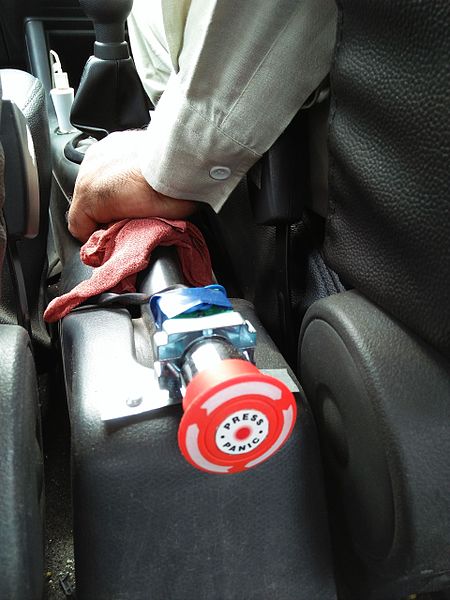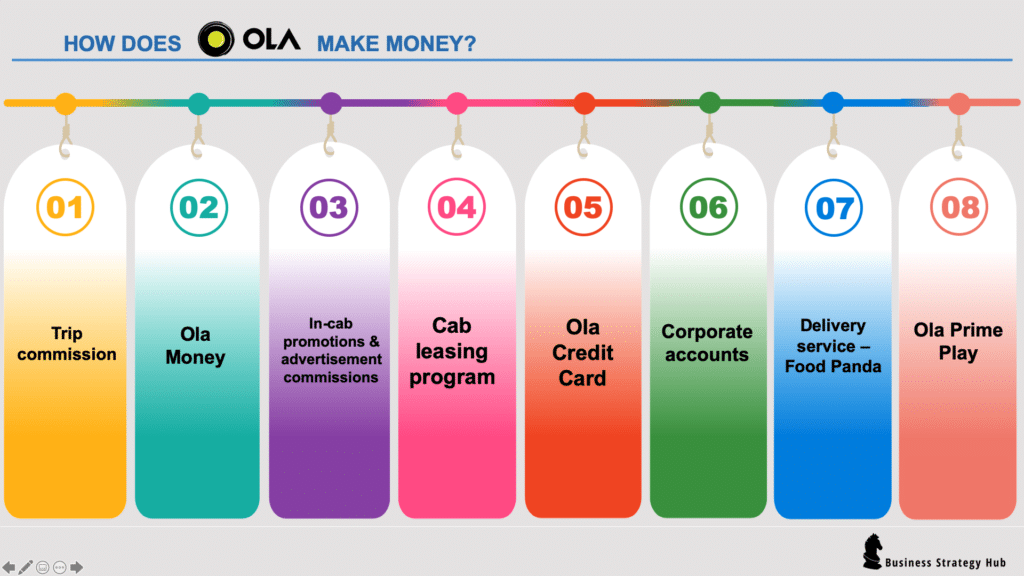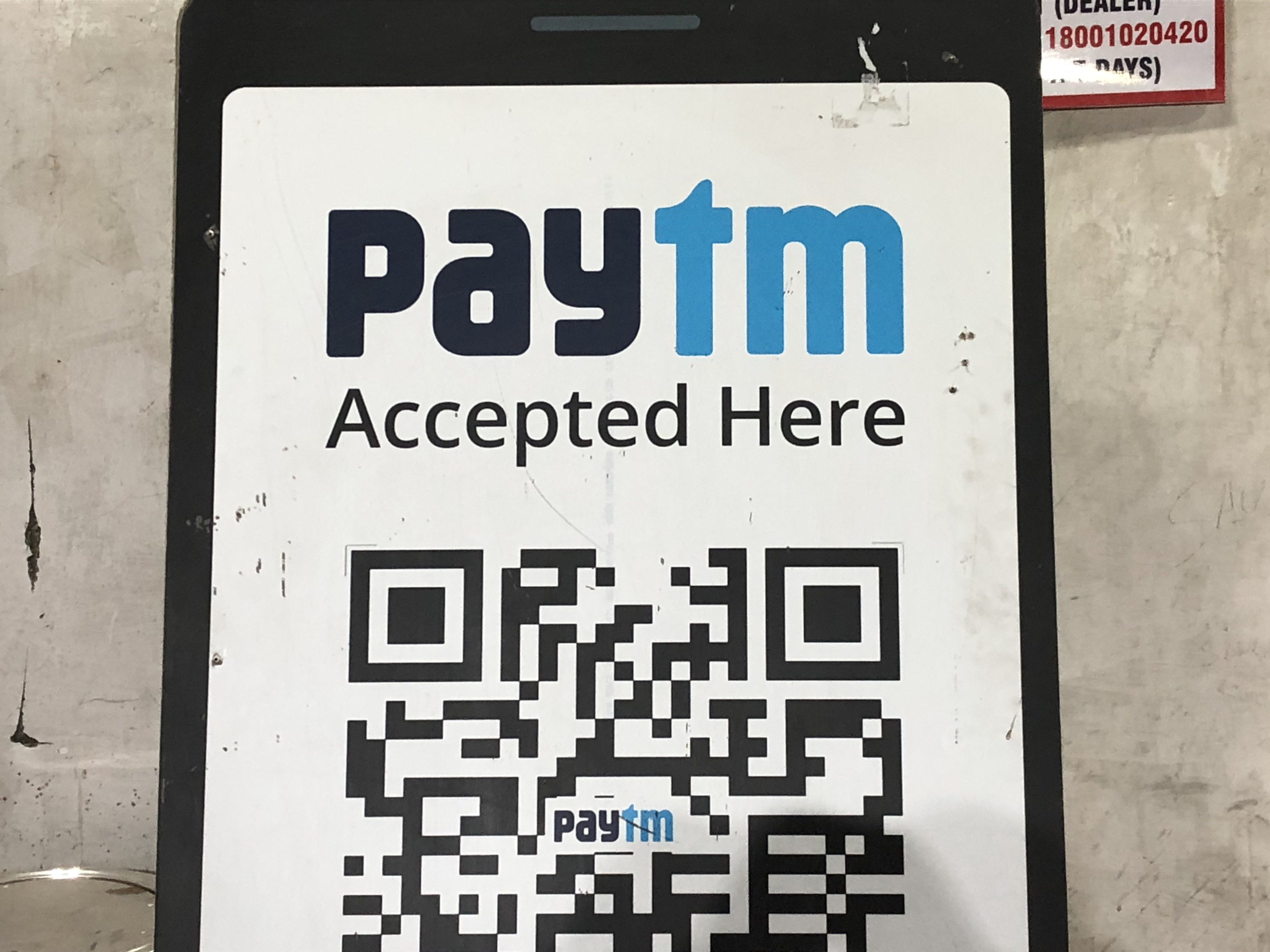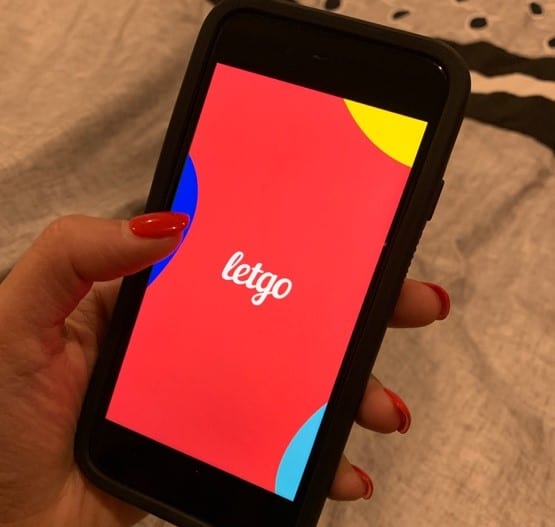Company: Ola Cabs
CEO: Bhavish Aggarwal
Year founded: 2010
Headquarter: Bengaluru, India
Number of Employees (Dec 2019): 8,000
Type: Private
Valuation (Dec 2019): $10 Billion
Annual Revenue (FY2019): Rs 2,543.63 crore
Profit | Net income (FY2019): Rs 2,593 crore
Products & Services: Online ride-sharing services | Food delivery service | Mobile wallet
Competitors: Uber | Grubhub | Swiggy | Lyft | Grab | Bolt (Taxify) | Wheely | TaxiForSure | Meru | UberEats | PayTM

When it comes to reaching your destinations on time, several on-demand taxi services would probably come into your mind. Undoubtedly, one of them would be Ola. India’s largest domestic ride-hailing service company and Uber’s greatest rival in India, Ola was founded in 2011, offering efficient transportation services to people.
Based on the two-sided network model, Ola connects customers seeking on-demand transportation with driver partners through a mobile app.
Ola serves millions of customers every day in over 169 cities. There are over 125 million users registered at Ola currently. The services of Ola are also effective in Australia, New Zealand, and the United Kingdom.
Let’s dig into Ola’s business model canvas to explore the company in depth and find out how Ola makes money.
Business Model Canvas of Ola
1. Customer Segments of Ola
There are two customer segments of Ola:
Users of taxi service:
- City Taxi – Everyday commuters who want to book a cab to reach from one place to other, people who don’t like to drive instead enjoy working while on the go.
- Outstation or intercity Taxi – Friends and Families who want to travel to some place together for outstation travel.
- Rentals – People who enjoy driving has an option to rent a car for as little as 1 hour or up to 12 hours.
- Ola Corporate – Corporate customers who want to manage employee travels (pick/drop services), insurance, expenses, and invoices through a centralized portal or dashboard.
Drivers (taxi service providers):
Driver partners owning eligible cars, who provides taxi services and earn through the Ola platform.
- expenses, and invoices through a centralized portal or dashboard.
Bikers (bike service providers):
Bike and rickshaw owners can provide bike taxi services and earn on the Ola Bike platform. Ola Bike has more than 300,000 bike partners. [1]
2. Value Propositions of Ola
The value propositions of Ola are as follows:
For Passengers
- its affordable and lean fares
- high-quality service and convenient rides
- Certified drivers
- Criminal background check
- active customer support system
- advance booking
- multiple stops facility
- hourly packages for rental cabs, share and express rides,
- zero wait time with Ola Select membership program
- cashless rides and
- in-cab entertainment with Ola Play
For Drivers partners:
- Choose your own working hours
- Access to more customers
- Instant booking
- Daily Payments
- 24/7 helpline support
- Lease cars get free car maintenance and
- Run and manage the fleet of cars
Loss of income cover – Announced in March 2020, this cover provides Rs 30,000 to each driver infected or affected by the health crisis. Drivers and their spouses can receive a compensation of Rs 1,000 per day for 21 days. [2]
3. Customer Relationships of Ola
The customer relationships of Ola can be gauged by the pleasant experiences and satisfaction of the customers and driver partners.
Self-Serve App – Ola app is mostly a self-serve portal with 24/7 customer support.
Promotions offer – it maintains relationships with customers by offering them referrals credit points, various offers for their first ride, credits points if a trip is delayed or canceled by any reason, and many other promotions and discount offers.
In-App and Live Services – Ola provides 24/7 call and emergency (SOS) alert button in the app for exceptional customer service and support.

4. Channels of Ola
The channels of Ola include:
- Self-Serve – its hi-tech mobile application available on iOS, Android, and Windows. It also utilizes SMS and emails notifications to work with customers and driver partners.
- Partner Channel – Other delivery channels are its extensive range of vehicles that include autos, bikes, micro, mini, Prime Sedan, Prime SUV, Prime Play, LUX, E-Rick, and Kaali Peeli.
- Social Media – It also efficiently manages its social media pages and thrive in communications with customers. It keeps asking for feedback from customers to improve their services
5. Key Resources of Ola
The key resources of Ola are:
- Technology – its mobile technology platform
- Brand Reputation – Ola has created significant brand equity for itself.
- Employees – its employees and staff working in the domains of IT, sales, marketing, customer support, and finance and business management
- Engaged Community – its vibrant community of passengers and drivers that uses Ola services every day.
- Driver partners – Experienced, trained, and qualified drivers are also its key resources.
- Shareholders and investors – Ola’s major investors include SoftBank Group at 26.1%, Tiger Global at 15.94%, Tencent at 10.39%, Matrix Partners at8.57 %, DST Global at 6.72%, and others. Bhavish Aggarwal holds a 7-7.5% stake in the company. [3]
6. Key Activities of Ola
Major key activities of Ola are given as below:
- Platform growth – Managing and updating mobile app on a constant basis
- Manage daily operations, which includes –
- Ensuring safe, secure, prompt and convenient rides
- Hiring, verifying and training of drivers. Ola announced in October 2020 that it plans to hire about 1,000 engineers over the next few years. The engineers will work in its second technology center to be opened in Pune, which will cater to both global and local solutions for all businesses of Ola. [4]
- Providing time-to-time incentives and commissions to drivers
- Performing car audits to ensure the quality, value, and maintenance of vehicles
- Manage relationship – Managing relationships with customers, partners, and investors
- Government Compliance – Understanding and complying government regulations and RTO rules in the areas where it’s operating
- Sales & Marketing – Planning and executing promotion and marketing techniques – both online and offline
- Manage Finance, which includes
- Raising funds & develop an effective pricing strategy
- Administrating financial, operational, and functional tasks
- Performing surprise audits occasionally to ensure that the services are being delivered up to par, meeting the company’s expectations.
- Acquisitions for expansion – In May 2020, Ola acquired Amsterdam-based electric scooter startup Etergo BV to expand the capabilities of Ola Electric. The acquisition allows Ola Electric to build on the battery technology already developed by Etergo and deliver high energy batteries to the market quicker. In the previous financing round, Etergo was valued at around $90 million. [5]
7. Key Partners of Ola
The key partners of Ola include

Driver partners:
- Car drivers
- Car fleet owners
- private taxi owners
Operational partners:
- Technology enablement partners such as GPS service provider, Internet service provider, electronic or mobile wallet, platform hosting company, etc.
Extended Partners:
- Event organizers
- Corporate association
- Auto – Insurance companies
- Automotive maintenance companies
- Drug and background check companies
- Driving school or training institutes
- Bike partners – Ola diversified into the bike taxi service sector by launching Ola Bike to counter the saturation of the cab services market. Ola Bike has more than 300,000 bike partners and about 25% of the market share. The bike taxi service is growing at 20% month-over-month and is now a $150 million market. [6]
8. Cost Structure of Ola
Ola’s primary sources of costs include:
- Platform cost:
- New feature development
- Sales & Marketing:
- promotion and branding costs
- discount offers and deals
- partners and community events
- Operational cost:
- Employee salaries – In May 2020, Ola’s revenues plunged 95% in two months prompting the company to lay off 1,400 employees to reduce costs. [7]
- legal and accounting expenses
- Commission to drivers
- infrastructure cost,
- web/app hosting cost
- Insurance cost
- Maintenance of lease vehicle
- Credit card/ mobile wallet processing cost
- day-to-day office maintenance expenses
- Assets cost:
- Computer equipment – phones, tablets, etc.
9. Revenue Streams of Ola
Let’s look at Ola’s revenue sources in more detail.

How does Ola make money?
The question ‘how does Ola make money’ would be answered once we take a dive into its revenue streams. Ola earns through various ways which are described as below:
1. Trip commission
Ola charges percentage commission from the trips being carried out through its platform. It charges trip fares from customers through several factors (below), some of these factors are applicable based on location, car type, etc.
- Base fare – it’s an initial flat fare
- Distance per km Fare – is charged based on distance traveled per km, after initial fixed fare distance (differs from car to car and geographical location)
- Ride time fare – A fare charged based on the total time of the trip from pick up to drop off. Customers will be charged based on travel time in minutes.
- Wait time fare – is imposed if the driver had to wait
- Peak Pricing – During high demands for cabs, Ola increases the rates per km. It may also increase the rate of slabs depending on the type of car to generate more revenue. Your charges will vary according to the car you have selected at the time of booking. These charges include a fixed rate per km, per km travel charges and driver’s waiting time.
- Advance booking fees – there is an advance booking fee that is charged on all rides that are booked for later use.
- Access fees – it’s a fee for auto rides
- Convenience fee – its applicable to ride that provides in-cab entertainment
- Airport fees – surcharge fees are charged in case of airport pickup/ drop off
- Tool and parking fees – it’s based on the usage, when applicable
- A cancelation fee may be charged for canceled rides in certain conditions (fees vary as per rides and regions).
- Service Tax – is also charged on the entire trip fare
Once the travel fare is charged to your Ola Money Wallet, it will be credited to the driver’s account. If it is paid in cash, the same amount will be deducted and included in driver’s payment for the trips he has conducted.
Moreover, Ola deducts the service tax from customers’ payment firstly. Then, it charges commissions percentage. Finally, it pays the remaining amount to the driver’s bank account within 2 working days.
An estimated commission that Ola charges per trip:
- Introductory promotion: 7.5 % commission for new drivers for a limited period
- In India: Ola charges about 20% commission
- In the UK: Ola charges 10% for metered taxi and 15% for Private Hire Vehicle(PHV)
- In New Zealand: Ola charges about 18% commission
- In Australia: Ola charges about 15 – 22.5% commission
Also read: what Uber charges for commission?
2. Ola Money
Ola has also introduced its money wallet just like PayTM wallet and FreeCharge wallet. Through Ola’s virtual wallet service, payments can be made at various vendor touch points. The wallet also incorporates its own services of cab-hailing payments. This contributes to the revenue of Ola.
3. In-cab promotions and advertisement commissions
Brochures, pamphlets, or other advertising tools are given to commuters. Live streaming ads from different advertisers are played to promote different company’s products and services. Ola charges commissions for these promotions.
4. Cab leasing program
Ola has started a cab leasing program for its driver partners. It buys cars and leases them out to drivers to enhance the loyalty of drivers towards Ola.
There is an initial fee of Rs 4000 non-refundable fees and Rs 21,000 – 31,000 refundable security deposit. Also, a fixed daily fee amount of Rs 700 -1150 is charged to the drivers for running the vehicle while the travel fare revenue goes to the driver. So, it can be an aggregate of both fixed fee and trip-based commission. In March 2020, Ola waived lease rentals for drivers under its leasing program to help them recover from market uncertainties. Drivers were also demanding Rs 10,000 as an interest-free loan. [8]
5. Ola Credit Card
Ola has introduced a credit card “Ola Money SBI Card” in association with SBI and Visa. The card offers many benefits and rewards to its consumers.
6. Corporate accounts
Ola performs several business meetings with the heads of various organizations where they promote Ola and convince corporate managers and employees to use Ola cabs for their business travels. Reduced rates are charged from these corporates as demand increases. With these B2B tie-ups, Ola earns a higher sales volume.
7. Delivery service – FoodPanda
With FoodPanda acquisition, Ola successfully entered into online food delivery segment. Ola is expected to take on UberEats and Swiggy, increase its profits, and thus develop a strong position in the food delivery market soon.
8. Ola Prime Play
Ola has made a partnership with Microsoft, Sony Liv, Apple Music, Audio Compass, etc. to provide commuters in-cab personalized entertainment. Ola makes money on some of those rides providing entertainment services. Ola is charging passengers Rs 20 as a convenience fee for in-cab entertainment.
Future Revenue Stream: Ola Electric
Ola Cabs launched Ola Electric Mobility Pvt Ltd, which has been laying the foundation and will soon release an electric scooter to the market as its first product. In the next few years, Ola Electric is expected to build electric vehicles and batteries under Battery-as-a-Service (BaaS) model for shared mobility. CEO Bhavish Aggarwal announced plans to recruit about 2,000 people globally to deliver the project. The projected demand for electric cars and batteries in the coming years makes Ola Electric one of the biggest future revenue streams for Ola. [9]
Final Word
The taxi based model of Ola has served it quite well as their services are earnestly welcomed by almost everyone. An ultimate solution to reach destination promptly, conveniently and safely, Ola has truly redefined mobility for billions of people worldwide.
References & more information
- ET Bureau (2020, March 17). Bike taxis a $5 billion opportunity: Ola. Economic Times
- Kashyaap, S. (2020, Mar 21). Ola offers Rs 30,000 cover for driver-partners and their spouses affected by a coronavirus. Your Story
- Dalal, M. (2020, June 10). How Ola is hunkering down to ride out the storm. Live Mint
- PTI (2020, Oct 18). Ola to set up a new tech center in Pune, hire 1,000 engineers. Economic Times.
- Singh, M. (2020, May 27). Ola Electric acquires Etergo to launch its own line of electric two-wheelers this year. Tech Crunch
- Mukherjee, S. (2019, Dec 18). Ola targets 1 million bike partners by next year. Economic Times
- Browne, R. (2020, May 20). SoftBank-backed Ola lays off 1,400 employees as coronavirus crisis hammers ride-hailing apps. CNBC
- Mahale, A. (2020, March 26). Ola to waive lease rental for drivers. The Hindu
- Panday, A. (2020, Aug 26). Ola Electric begins restructuring to hire 2000 people. Live Mint
Tell us what you think? Did you find this article interesting?
Share your thoughts and experiences in the comments section below.













Please send me business models to My email address given below.
Hi Akhilesh,
I have added you to our newsletter and you will receive all the latest posts via email.
Happy Reading !
can u plz send me business models of ola and uber to my mail
Hi Naman,
I have replied back to your email
Very knowledgeable and very impressive. Thanks for the info.
Regards
I want a some more detail about ola.
compare to other cab services in india ,who will be more capeble to earned more profit.